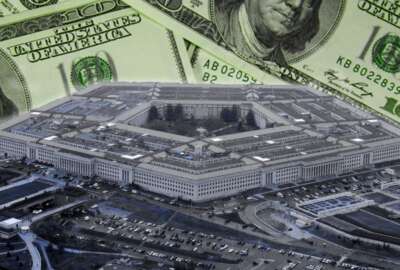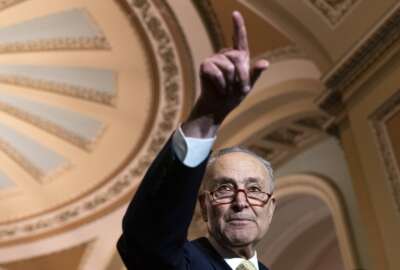That omnibus bill maybe should be called the omni-train, gravy train
Congress, as it does every year, crammed a lot of spending when it whipped up that so called omnibus appropriations bill.
Best listening experience is on Chrome, Firefox or Safari. Subscribe to Federal Drive’s daily audio interviews on Apple Podcasts or PodcastOne.
Congress, as it does every year, crammed a lot of spending when it whipped up that so called omnibus appropriations bill. Pretty much record setting spending all round. And the Federal Drive with Tom Temin got a summary now from WTOP Capitol Hill correspondent Mitchell Miller.
Interview transcript:
Tom Temin: And they did it by the skin of their teeth once again. But tell us some of the highlights that are interesting this year.
Mitchell Miller: Well out of that $1.5 trillion bill, which by the way, comes after nearly six months into the fiscal year, but it was finally passed, among the agencies that are getting more funding the Transportation Department, that will be a big one, because, as you know, the infrastructure bill was approved late last year. The Transportation Department’s going to have a big role in effectively moving hundreds of billions of dollars in infrastructure improvements. They’ll go to roads, bridges, improving internet connections. Other agencies that were winners, Health and Human Services, Labor, the Education Department, all of this part of more than $700 billion in domestic spending. There’s also more funding for cancer research, which has been a big priority for President Biden. And then the IRS is getting more money, about $675 million more, that’s the biggest increase in more than 20 years. Lawmakers here on the Hill are really concerned about the backlog of tax returns and other issues, which have piled up during the pandemic. And then on the Defense side, more defense spending and military pay raises. They were of course, approved during the Defense Authorization Act and have already been in effect since January. But this will help to pay for it. Separately, there’s more than $6 billion for military assistance to Ukraine that will be split between paying for U.S. troop deployments in Eastern Europe and restocking weapons that are going to be sent to Ukraine. So a lot of things really crammed into this overall legislation.
Tom Temin: Sounds like it happened before Congress could weigh in if they care to on the idea of that plane swap with Poland.
Mitchell Miller: Right, exactly. And that continues to be a controversial issue. In fact, late last week, right as this giant omnibus bill was about to be passed, Republican senators, close to 40 of them complained about the fact that the Pentagon had decided not to go along with this decision to basically backfill, as they say, with U.S. fighter jets to Poland, and then Poland would send its MiGs to Ukraine. I did talk to Virginia Sen. Tim Kaine, who’s a member of the Armed Services Committee. He indicated he does not think that this issue is fully settled. And he actually himself is open to the idea of some type of transfer of aircraft. As he pointed out, the U.S. has already been involved in a lot of transfers in connection with weapon systems and anti-artillery. And his point is if all these defense pieces of equipment are already being sent through eventually to Ukraine, what is the overall difference? But of course, there are a lot of technicalities in connection with NATO, and what constitutes an act of war, an act of aggression. Tim Kane’s point is Putin has already made an act of aggression. He knows we’re helping. What is really the difference? So I think there’s going to be a lot of discussions on that ongoing.
Tom Temin: Right, I guess the sense there is it’s hard to insult or incense or provoke Putin anymore since the existence of the West is an eternal provocation for him anyway. Why dilly dally over quibbling and details?
Mitchell Miller: Right, yeah, it’s very much a Western type of thing, right? That the democracies are actually concerned about these kinds of issues where obviously Vladimir Putin could really care less.
Tom Temin: So will this occupy Congress now that they have got this piece done? And it doesn’t look like the Build Back Better is going to be resurrected in this session? So what will they, do you think, be concerned about in the immediate near future?
Mitchell Miller: Well one thing that they are going to be concerned about, at least on the Democratic side is $15 billion, roughly was taken out of this omnibus, and that was essentially to get the whole thing through. There was a big kerfuffle right at the end of the week on the House side in connection with, including this money. And what essentially it boils down to is Republicans were putting pressure on Democrats saying, look, a lot of this money from COVID has not been spent. So why don’t we try to work it out so that all of the, some of the money can go toward this $15 billion? Well, in the process of writing up the more than 2,700 pages of this legislation, and then dropped in the middle of the night, as it often is, a lot of people started poring over it and said, “Hey, wait a second, our state is not going to get the second tranche of funding from COVID that we were supposed to.” Well, after they raised a lot of hackles about that, House Speaker Nancy Pelosi and the Democratic leadership decided, well, we’re going to punt on this one. So that one is potentially going to occupy lawmakers. Democrats want to somehow resurrect this. The White House says it really needs this money for vaccines for treatments. And then for testing in case there is some kind of variant that comes up again. Republicans are really pushing back on that. So it’s going to be difficult to see a path for that, at least that kind of money to be passed separately by Congress.
Tom Temin: We’re speaking with Mitchell Miller, Capitol Hill correspondent for WTOP. And while we’re on the subject to one last question on the congressional spending – pork, earmarks, they’ve sort of come back.
Mitchell Miller: That’s right, earmarks are back. There’s an old song with a refrain, “Too much pork for just one fork,” and lawmakers will need a lot of forks to dig into the thousands of earmarks that are in this legislation. They’ve returned basically after more than a decade absence. Congressional aides and watchdog groups have told The Hill that there’s more than 4,000 earmarks in this legislation. Not surprisingly, many are linked to appropriators, many of them, dozens of them in fact, have been linked to Senate Majority Leader Chuck Schumer, as well as many with Alabama Sen. Richard Shelby, who’s the ranking Republican, of course on the Appropriations Committee. The earmarks as you would expect deal with a wide range of porky projects, including Transportation, Housing, water projects for various states represented by senators. Senate Minority Leader Mitch McConnell did not have any of those earmarks attached to him. And Indiana Republican Sen. Mike Braun on Friday night tried to get an amendment passed to ban the earmarks. But that fell far short. By the way, The Hill, it’s interesting, noted that more than 10 years ago the number of earmarks was actually more than double of what’s in this legislation. But I’m guessing now that the earmarks are back, we are going to see that number steadily rise.
Tom Temin: I’m waiting for the Tom Temin radio tower somewhere here. But so far, I haven’t paid the right guys off to get it in there.
Mitchell Miller: You got to get it up to that trough, Tom.
Tom Temin: And let’s get to the federal agencies in this White House push for returning. It’s not all that clear that just by snapping his fingers, the president can get everyone back in the office.
Mitchell Miller: No, it’s interesting, because during the State of the Union address a few weeks ago, I really noticed this statement that he made in the middle of everything else, saying that he wants federal employees to set an example and he thinks that a majority of federal workers will be back in their offices soon. I’m sure a lot of federal employees took note of that as well as the managers. That’s led to some raised eyebrows ad agencies across Washington who have of course, as we’ve talked about a growing number of people who are teleworking, a lot of people still not returning to the roads and going back to their offices. So we’ll have to see how that plays out. And then maybe more moderate level. Federal agencies have been also told to revise their guidance for wearing masks in the workplace with everything kind of relaxing a bit. Here at the Capitol while some people still wear masks by their choice, the majority of staff lawmakers, Capitol police and media do not though reporters, if we’re in cramped quarters some reporters will choose to wear masks. But right now, most of the masks here in this Capitol Complex have disappeared.
Tom Temin: Interesting. I got yelled at at the Kennedy Center the other night for taking my mask off to eat an M&M. I don’t know whether she was madder about the M&M or the mask. It was quite a situation, getting jabbed in the ribs by my wife. And the Capitol itself might be reopening to the public after being closed for lo these many months.
Mitchell Miller: Yeah, as you walk around the hallways, and as I noted, people not wearing masks now there is a somewhat of a feeling of a return to normalcy. Certainly, the fact that all of these in-person gatherings with news conferences and hearings, there is a lot more in-person activity. And many of the lawmakers have made it very clear for some time that they would really like the Capitol reopened. In fact, just the other day, I was walking out of the Capitol and there were a couple of tourists that were walking, and they came up to a Capitol police officer and they said, oh, where’s the Capitol Visitor Center? And he said, just very matter of factly, “Well, it’s closed. In fact, it’s been closed for more than two years.” And they were like, whoa, really? So that’s what we’re dealing with. I mean, more than two years that we’ve not had school groups, tourists, all the normal people that come to the U.S. Capitol, but right now they are reviewing things. And I think that they will slowly move toward that. I don’t know if it’s going to be a matter of weeks or months. But certainly members of both parties want to do this. Republicans introduced a resolution several weeks ago saying they wanted to get it reopened. So I think at some point, perhaps later this year, we will likely see the Capitol finally reopened, which will really be celebrated by a lot of people here.
Tom Temin: And I understand the mask will be coming off the statue of Samuel Adams.
Mitchell Miller: That’s right. We’ll let him, we’ll give him that exemption.
Tom Temin: All right, Mitchell Miller is Capitol Hill correspondent for WTOP. Thanks so much as always.
Mitchell Miller: You bet.
Copyright © 2025 Federal News Network. All rights reserved. This website is not intended for users located within the European Economic Area.
Tom Temin is host of the Federal Drive and has been providing insight on federal technology and management issues for more than 30 years.
Follow @tteminWFED





